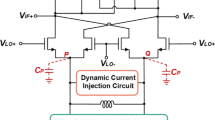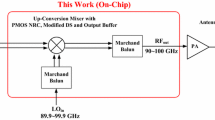Abstract
A 5.25 GHz low voltage, high linear and isolated mixer using TSMC 0.18 μm CMOS process for WLAN receiver was investigated. The paper presents a novel topology mixer that leads to better performance in terms of linearity, isolation and power consumption for low supply voltage. The measuring results of the proposed mixer achieve: 7.6 dB power conversion gain, 11.4 dB double side band noise figure, 3 dBm input third-order intercept point, and the total dc power consumption of this mixer including output buffers is 2.45 mW from a 1 V supply voltage. The current output buffer is about 2 mW, the excellent LO-RF, LO-IF and RF-IF isolation achieved up to 37.8, 54.8 and 38.2 dB, respectively.
















Similar content being viewed by others
References
IEEE 802.11a. (1999). Wireless LAN Medium Access Control (MAC) and Physical Layer (PHY) specifications: High-speed Physical Layer in the 5 GHz Band, IEEE Std 802.11a.
Manku, T. (1999). Microwave CMOS—Device physics and design. IEEE Journal of Solid-State Circuits, 34(3), 277–285.
Kim, T. W., Kim, B., & Lee, K. (2004). Highly linear receiver front-end adopting MOSFET transconductance linearization by multiple gated transistors. IEEE Journal of Solid-State Circuits, 39(1), 223–229.
Lee, S. G., & Choi, J. K. (2000). Current-reuse bleeding mixer. IEE Electronics Letters, 36(8), 696–697.
Darabi, H., & Abidi, A. A. (2000). Noise in RF-CMOS mixer: A simple physical model. IEEE Journal of Solid-State Circuits, 35(1), 15–25.
Yang, T. Y., Tu, H. L., & Chiou, H. K. (2006). Low-voltage high-linear and isolation transformer based mixer for direct conversion receiver. In Proceedings of IEEE international symposium circuits and systems (ISCAS), (pp. 21–24).
Sullivan, P. J., Xavier, B. A., & Ku, W. H. (1997). Low voltage performance of a microwave CMOS Gilbert cell mixer. IEEE Journal of Solid-State Circuits, 32(7), 1151–1155.
Sullivan, P. J., Xavier, B. A., & Ku, W. H. (1999). A common source input cross coupled quad CMOS Mixer. Journal of Analog Integrated Circuits and Signal Processing, 19(2), 181–188. (Springer science).
Rudell, J. C., Ou, J. J., Cho, T. B., Chien, G., Brianti, F., Weldon, J. A., et al. (1997). A 1.9-GHz wide-band IF double conversion CMOS receiver for cordless telephone applications. IEEE Journal of Solid-State Circuits, 32(12), 2071–2088.
Klumperink, E. A. M., Louwsma, S. M., Wienk, G. J. M., & Nauta, B. (2004). A CMOS switched transconductor mixer. IEEE Journal of Solid-State Circuits, 39(8), 1231–1240.
Chen, J. D., & Lin, Z. M. (2006). 2.4 GHz high IIP3 and low-noise down-conversion mixer. Proceedings of the IEEE Asia Pacific conference on circuits and systems, 37–40.
Weste, H. E. N., & Eshraghian, K. (1993). Principles of CMOS VLSI design (Vol. 2). Reading, Massachusetts: Addison Wesley.
Johns, D. A., & Martin, K. (1997). Analog integrated circuit design. New York: Wiley.
Razavi, B. (2001). Design of analog CMOS integrated circuit. New York: McGraw-Hill.
Feng, C. H., Jonsson, F., Ismail, M., & Olsson, H. (1999). Analysis of nonlinearities in RF CMOS amplifiers. The 6th IEEE International Conference on Electronics, Circuits and Systems, 1, 137–140.
Zhang, L. J., Li, W., & Yuan, J. S. (2001). CMOS RF mixer no-linearity design. Proceedings of the 44th IEEE Midwest Symposium on Circuits and Systems, 2, 808–811.
Hsu, H. M., & Lee, T. H. (2006). High LO-RF isolation of zero-IF mixer in 0.18 μm CMOS technology. Journal of Analog Integrated Circuits and Signal Processing, 49(1), 19–25. (Springer Science).
Heydari, P. (2006). An analysis of high-frequency noise in RF active CMOS mixers. Journal of Analog Integrated Circuits and Signal Processing, 48(3), 199–209. Springer Science.
Meng, C. C., Xu, S. K., Wu, T. H., Chao, M. H., & Huang, G. W. (2003). A high isolation CMFB down conversion micromixer using 0.18 μm deep n-well CMOS technology. Proceedings of the IEEE Radio Frequency Integrated Circuits (RFIC), 619–622.
Vidojkovic, V., Tang, J. V. D., Leeuwenburgh, A., & Roermund, A. V. (2005). A low-voltage folded-switching Mixer in 0.18-μm CMOS. IEEE Journal of Solid-State Circuits, 40(6), 1259–1264.
Park, J., Lee, C. H., Kim, B. S., & Laskar, J. (2006). Design and analysis of low flicker-noise CMOS mixers for direct-conversion receivers. IEEE Transactions on Microwave Theory and Technology, 54(12), 4372–4380.
Lee, S. Y., Huang, M. F., & Kuo, C. J. (2006). A 5.25-GHz CMOS folded-cascode even-harmonic mixer for low-voltage applications. IEEE Transactions on Microwave Theory and Technology, 54(2), 660–669.
Acknowledgments
The authors would like to thank National Chip Implementation Center (CIC) for technical support, Taiwan, R.O.C.
Author information
Authors and Affiliations
Corresponding author
Rights and permissions
About this article
Cite this article
Chen, JD., Lin, ZM. & Row, JS. A 5.25-GHz low-power down-conversion mixer in 0.18-μm CMOS technology. Analog Integr Circ Sig Process 62, 301–312 (2010). https://doi.org/10.1007/s10470-009-9347-1
Received:
Revised:
Accepted:
Published:
Issue Date:
DOI: https://doi.org/10.1007/s10470-009-9347-1




